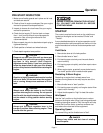
Page 13
Tips
TILLING TIPS
The key to successful tilling is to begin with a shallow
cut on the first pass, and then work an inch or two
deeper on each successive pass.
✮ Tilling depth will vary with ground conditions.
✮ When beginning to till in unbroken ground or in
extremely hard soil, set the detent pin in the highest
hole of the drag stake (follow instructions under
Tilling on previous page). This will allow for shallow
tilling. With the drag stake in this position, make
several light passes over the area to be tilled. Reset
for deeper depths with successive passes.
✮ If tiller jumps or skids uncontrollably, lower the drag
stake by placing the detent pin in a higher hole. This
will allow for shallower tilling. Hold firmly to the
handlebars to control sudden lurches.
✮ If weeds, tall grasses, vines, or other materials clog
or jam the tines, reverse the tiller to unwind
vegetation.
Immediately release the drive control levers if the tines
jam or you strike a foreign object. With drive control
levers in neutral, push throttle control to stop position to
stop the engine. Disengage the spark plug wire. When
tines have stopped, remove foreign objects and check
for damage.
CULTIVATING TIPS
If you plan to use your tiller for cultivating:
✮ Plant rows on 20" - 22" centers for ease of turning.
✮ Set the drag stake with the detent pin in one of the
higher holes. This will allow the shallow cultivation
necessary to turn over weeds, and break up and
aerate the soil.
Extreme caution must be taken in selecting tilling
depth. If you attempt to till too deeply for soil conditions,
that is, with the drag stake in too high a position,
loss of control could result.
If removing material from the tines by hand, stop
engine and remove spark plug wire first.
WARNING
WARNING


















